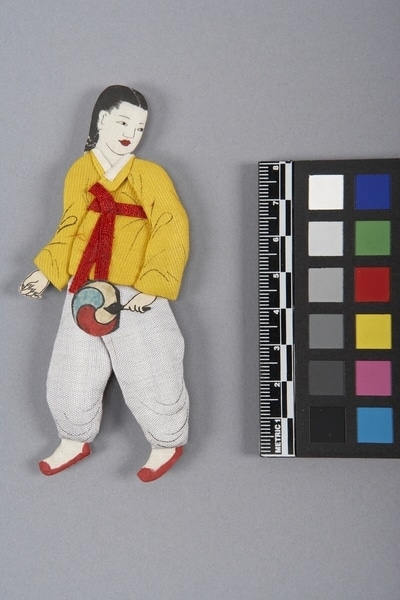Doll Item Number: Ed1.119 from the MOA: University of British Columbia

Description
Figure representing a person on a flat backing of white paper. Front view is depicted of the figure which is made of cloth lightly padded to give a three-dimensional effect having each portion made of a separate piece of cloth with painted details. Hands are made of paper. Face is made of white silk. Figure's left hand is holding a flat circular red, green, and yellow fan. Black hair is parted in the centre, and combed in a braid. Wearing a yellow cotton shirt tied under the arms with a red ribbon, loose light blue-grey silk trousers, white socks, and low red shoes. Two pieces of white flannel hemmed in light red-pink silk with a loop of the same at the top are sewn to the paper backing.
History Of Use
Figure represents boy from late 19th to early 20th centuries. At that time, boys wore their hair in a long braid until marriage, when it was combed into a topknot. After marriage a hat was always worn. Such figures were made during the time when Korea was first open to the outside world (after the mid 1890s), probably as gifts to present to missionaries or other visitors from foreign countries. Flat dolls like these were very popular during the period 1910-20. Before that time, shamans made dolls that they sold to their clients, as images of those the clients wanted to exorcise. Simple dolls were made of straw for children to play with. After Korea opened, people began to see dolls as artistic objects. They were made in workshops by masters, using authentic fabrics whenever possible, as their purpose was to introduce foreigners to Korean society. Young boys of the official “yangban” class dressed in this way at home. Boys until the age of five or six wore a ribbon belt tied at the underarm level. Their hair was worn in a braid at the back
Narrative
Collected by J. H. Morris while he was chief engineer for Seoul Railway, Korea.
Specific Techniques
The clothing was stitched around the edge and then a layer was added inside the clothing. Each section was separately applied and pasted in place. The details were finely painted.
Iconographic Meaning
The underarm ribbon and the yellow colour of the boy’s jacket “Jo-go-ri” indicate that he is no older than six or seven years old. The quality of his clothes and his flat fan indicate that he is of the official “yangban” class.
Item History
- Made in Korea during 1910
- Collected between 1910 and 1939
- Owned by Marion Stephan before August 1964
- Received from Marion Stephan (Donor) during August 1964
What
- Name
- Doll
- Identification Number
- Ed1.119
- Type of Item
- doll
- Material
- paper, silk fibre, cotton fibre, rayon fibre ?, paint and paste adhesive
- Manufacturing Technique
- spun, woven, cut, painted, sewn and pasted
- Overall
- height 11.1 cm, width 5.0 cm, depth 0.8 cm
Who
- Culture
- Korean
- Previous Owner
- Marion Stephan
- Received from
- Marion Stephan (Donor)
Where
- Holding Institution
- MOA: University of British Columbia
- Made in
- Korea
When
- Creation Date
- during 1910
- Collection Date
- between 1910 and 1939
- Ownership Date
- before August 1964
- Acquisition Date
- during August 1964
Other
- Condition
- good
- Current Location
- Case 77
- Accession Number
- 0113/0022